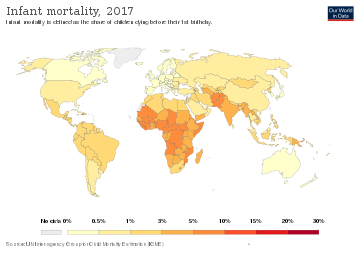
Infant mortality is the death of an infant before the infant's first birthday.[1] The occurrence of infant mortality in a population can be described by the infant mortality rate (IMR), which is the number of deaths of infants under one year of age per 1,000 live births.[1] Similarly, the child mortality rate, also known as the under-five mortality rate, compares the death rate of children up to the age of five.[2]
In 2013, the leading cause of infant mortality in the United States was birth defects.[3] Other leading causes of infant mortality include birth asphyxia, pneumonia, neonatal infection, diarrhea, malaria, measles, malnutrition,[4] congenital malformations, term birth complications such as abnormal presentation of the fetus, umbilical cord prolapse, or prolonged labor.[5] One of the most common preventable causes of infant mortality is smoking during pregnancy.[6] Lack of prenatal care, alcohol consumption during pregnancy, and drug use also cause complications that may result in infant mortality.[7][failed verification] Many situational factors contribute to the infant mortality rate, such as the pregnant woman's level of education, environmental conditions, political infrastructure, and level of medical support.[8] Improving sanitation, access to clean drinking water, immunization against infectious diseases, and other public health measures can help reduce rates of infant mortality.
In 1990, 8.8 million infants younger than one-year-old died globally[9] out of 12.6 million child deaths under the age of five.[10] More than 60% of the deaths of children under-five are seen as avoidable with low-cost measures such as continuous breastfeeding, vaccinations, and improved nutrition.[11] The global under-five mortality rate in 1950 was 22.5%, which dropped to 4.5% in 2015.[10] Over the same period, the infant mortality rate declined from 65 deaths per 1,000 live births to 29 deaths per 1,000.[12] Globally, 5.4 million children died before their fifth birthday in 2017;[13] by 2021 that number had dropped to 5 million children.[14]
The child mortality rate (not the infant mortality rate) was an indicator used to monitor progress towards the Fourth Goal of the Millennium Development Goals of the United Nations for the year 2015. A reduction in child mortality was established as a target in the Sustainable Development Goals—Goal Number 3: Ensure healthy lives and promote well-being for all at all ages.[15] As of January 2022[update], an analysis of 200 countries found 133 already meeting the SDG target, with 13 others trending towards meeting the target by 2030.[16] Throughout the world, the infant mortality rate (IMR) fluctuates drastically, and according to Biotechnology and Health Sciences, education and life expectancy in a country are the leading indicators of IMR.[17] This study was conducted across 135 countries over the course of 11 years, with the continent of Africa having the highest infant mortality rate of any region studied, with 68 deaths per 1,000 live births.[17]
- ^ a b "Infant Mortality | Maternal and Infant Health | Reproductive Health | CDC". www.cdc.gov. 2022-09-08. Retrieved 2023-04-07.
- ^ "Under-Five Mortality". UNICEF. Retrieved 2017-03-07.
- ^ Mathews TJ, MacDorman MF, Menacker F (January 2002). "Infant Mortality Statistics from the 1999 Period: Linked Birth/Infant Death Data Set" (PDF). National Vital Statistics Reports. 50 (4): 1–28. doi:10.1037/e558952006-001. hdl:1903/24216. PMID 11837053.
- ^ "Infant Mortality & Newborn Health". Women and Children First. Retrieved 2017-04-25.
- ^ "Labor and Delivery Complications -- the Basics". WebMD. Retrieved 2017-03-16.
- ^ Hall ES, Venkatesh M, Greenberg JM (November 2016). "A population study of first and subsequent pregnancy smoking behaviors in Ohio". Journal of Perinatology. 36 (11): 948–953. doi:10.1038/jp.2016.119. PMID 27467563. S2CID 29303225.
- ^ CDC (2020-06-03). "Commit to Healthy Choices to Help Prevent Birth Defects | CDC". Centers for Disease Control and Prevention. Retrieved 2020-07-30.
- ^ Genowska A, Jamiołkowski J, Szafraniec K, Stepaniak U, Szpak A, Pająk A (July 2015). "Environmental and socio-economic determinants of infant mortality in Poland: an ecological study". Environmental Health. 14 (1): 61. Bibcode:2015EnvHe..14...61G. doi:10.1186/s12940-015-0048-1. PMC 4508882. PMID 26195213.
- ^ "Infant Mortality". World Health Organization. 2020. Archived from the original on March 24, 2014. Retrieved 22 October 2020.
- ^ a b Roser M (2013-05-10). "Child Mortality". Our World in Data.
- ^ "WHO | Child mortality". www.who.int. Archived from the original on March 14, 2011. Retrieved 2017-03-16.
- ^ "Mortality rate, infant (per 1,000 live births) | Data". data.worldbank.org. Retrieved 2019-03-24.
- ^ "Children: reducing mortality". www.who.int. Retrieved 2020-07-31.
- ^ "Under-five mortality". UNICEF. January 2023.
- ^ "Sustainable Development Knowledge Platform". UN-DESA. Retrieved 23 April 2016.
- ^ "Global, regional and national trends in under-5 mortality between 1990 and 2019 with scenario-based projections until 2030". UNICEF. January 20, 2022.
- ^ a b Alijanzadeh, Mehran; Asefzadeh, Saeed; Moosaniaye Zare, Seyed Ali (2016-02-05). "Correlation Between Human Development Index and Infant Mortality Rate Worldwide". Biotechnology and Health Sciences. 3 (1). doi:10.17795/bhs-35330 (inactive 1 November 2024). ISSN 2383-0271. S2CID 73614487.
{{cite journal}}: CS1 maint: DOI inactive as of November 2024 (link)